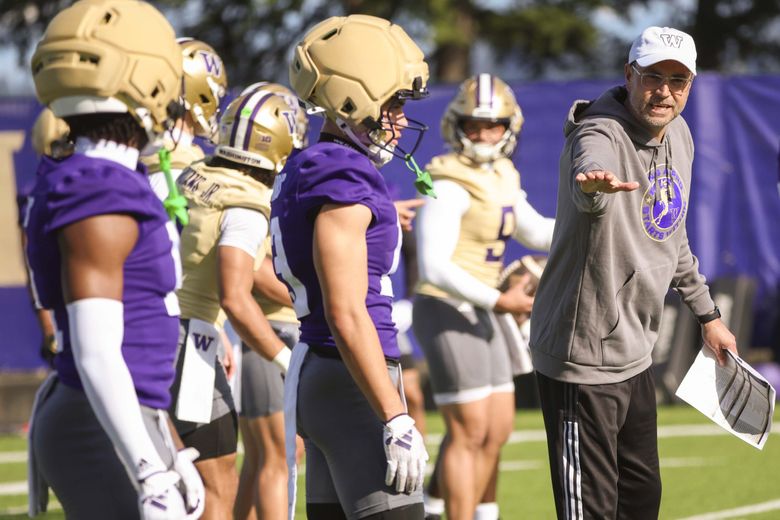UW football knows it must improve in red zone: ‘That’s the bottom line’ (Seattle Times)

Washington offensive coordinator and quarterbacks coach Jimmie Dougherty gives instructions during practice at Husky Stadium in Seattle on Thursday, April 3, 2025. (Ivy Ceballo / The Seattle Times)
By Andy Yamashita Seattle Times staff reporter
For Jimmie Dougherty, spending large portions of Washington’s third practice working in the red zone served two purposes.
First, it’s an easy way, the Washington offensive coordinator explained, to avoid soft-tissue injuries. Players are still ramping up their conditioning and fitness. By practicing in the red zone, Dougherty and coach Jedd Fisch aren’t asking players to reach top-end speeds racing deep down the field and risking muscle pulls or strains.
But more importantly, Dougherty admitted UW’s performance in the red zone during the past season simply wasn’t good enough.
“That’s the bottom line,” he said. “We’ve got to be better.”
Dougherty and the Huskies completed their third practice of fall camp Friday morning on the east practice field. Dougherty, promoted to offensive coordinator in February following Brennan Carroll’s departure for the NFL’s Las Vegas Raiders, is now responsible for a group whose red-zone offense ranked 74th in the FBS during the past season, tied with Baylor, California and Fresno State.
The Huskies struggled to convert red-zone trips into points throughout 2024. Washington made 47 trips inside an opponent’s 20-yard line during Fisch’s first season, just five behind College Football Playoff participant Clemson. UW had 36 red-zone attempts during Big Ten play, four behind conference runners-up Penn State. Ohio State, the eventual national champions, had 38 red-zone attempts in conference play.
Advertising Skip AdSkip AdSkip Ad
But Washington failed to convert those opportunities at the same rate as those playoff teams. UW scored during only 39 of its trips to the red zone — 83%. Penn State finished the season converting 89.4% of its red-zone opportunities, while Ohio State scored during 88.7% of its chances. Clemson, the worst of the group, still converted 86.5% of its red zone trips.
UW also settled for more red-zone field goals than any other Big Ten school during conference play, attempting 15 kicks and making 11. Ohio State and Penn State combined to attempt 15 red-zone field goals during conference play.
“Those plays are important,” Dougherty said. “Those are four-point plays when you get down there. You’re going to kick a field goal, or you’re going to score a touchdown. We’ve got to find ways to get in the paint, get in the end zone. That’s our main focus.”
Dougherty said an offense needs two traits to execute well in the red zone: a strong running game and receivers who can win one-on-one matchups.
The Huskies scored four rushing touchdowns during their red-zone sessions Friday. Senior running back Jonah Coleman found the end zone from 15 yards out after bouncing a run to the right, then powered in from the 4-yard line shortly before the end of practice.
Redshirt senior Jordan Washington and sophomore quarterback Demond Williams Jr. also tallied rushing scores from 12 and 7 yards, respectively. Dougherty praised the offensive line’s growth from a season earlier, and particularly junior center Landen Hatchett’s play during Friday’s practice.
Advertising Skip Ad
“We’re just so much faster in our identifications,” Dougherty said, “knowing where to go. Guys are that much more confident playing right now, and that’s the biggest thing with offensive lines, is that they’ve got to play as one unit — all five guys together — and we’re seeing that now.”
Washington’s search for strong one-on-one receivers, however, will continue as the position battle for two of the three starting spots raged Friday. The Huskies already have a strong one-on-one end zone target in Denzel Boston, whose nine receiving touchdowns led the team in 2024.
But Boston remained sidelined as he recovers from offseason cleanup surgery and isn’t expected back for at least another week, Fisch said Wednesday. So several receivers got opportunities to make plays in the end zone Friday.
Sophomore Rashid Williams, a 6-foot-1, 190-pound wideout from Northern California, caught a 4-yard touchdown from Demond Williams on the final play of practice. However, Rashid Williams almost made the catch of the day when he hauled in a one-handed catch on another Demond Williams’ pass along the left sideline, only to be ruled out of bounds.
Along with Rashid Williams, a majority of the opportunities fell to true freshman Raiden Vines-Bright, sophomore Audric Harris and junior Kevin Green Jr.
Dougherty noted that true freshman Chris Lawson, who’s been limited because of injury through the first three practices, will also have a chance to play early after impressing during spring practices. However, Dougherty did not have a timeline for Lawson’s return.
Advertising Skip AdSkip AdSkip Ad
Evans caught a 5-yard touchdown from freshman quarterback Treston “Kini” McMillan during the 7-on-7 period and a 4-yard touchdown from fifth-year quarterback Kai Horton during the 11-on-11 period. Harris added a 20-yard touchdown catch on a Demond Williams’ pass during the first scrimmage period of the spring.
“I feel like you can really see the work they put in,” Demond Williams said. “I appreciate them for that.”
Dougherty said wide receiver remains the offense’s closest position battle early in fall camp. He complimented the team’s depth, but said consistency, playmaking and football intelligence will be the most important abilities he’s looking for before the season.
“There’s a ton of guys that can play,” he said. “And now it’s just about who flashes the most? Who can make the biggest plays for us? Who knows what to do? Who’s assignment sound, play in and play out?”
Andy Yamashita: ayamashita@seattletimes .com. Seattle Times staff reporter Andy Yamashita covers UW football.
